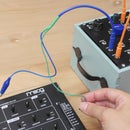Introduction: Make a Simple Pattern
In this lesson, you learn how to make a pattern for the Hi-5 Collector. The design is part glove and part bracelet. I've decided that it is a kind of mitt, so when I reference "the mitt", I am talking about the final project. :)
You will learn:
+ how to alter a simple pattern
+ how to do simple fit adjustments
Step 1: Materials
+ felt
+ fabric marker
+ soft measuring tape
+ ruler
+ straight pins
+ regular thread
+ hand needle
+ scissors
+ handmade switch from Introducing the Switch lesson
Step 2: Create or Hack a Pattern?
Fabric is the main substrate you'll use when creating wearable electronics. This fabric can come in two different forms:
1) A project that is cut and sewn together from yardage, often using a pattern
2) An already sewn garment that you augment.

They both have their pros and cons. In this lesson, you will create your own pattern from scratch. When prototyping, creating your own piece gives you more control and introduces you to the process of making a custom accessory using fabric.
Step 3: Measure
For this simple pattern, it's ok to draw straight onto the fabric. You are welcome to make a paper pattern for future use.
First, grab the soft measuring tape and take some measurements. Write down the measurements from the three places illustrated above.
1) Across the knuckles
2) Length of back of hand from knuckles to wrist
3) Circumference of wrist
Step 4: Mark Pattern
The final pattern consists of 3 pattern pieces:
1) Back of hand
2) Wrist strap
3) Handmade switch with strap
One and two are created using the measurements taken in the previous step. Number three you already created in the Introducing the Switch lesson. Grab a fabric marker and a ruler and draft these two pattern pieces:
Back of Hand
Use the fabric marker to draw out the three measurements you took on a piece of felt as pictured. Add .25" to each measurement. Remember it's easier to cut away from fabric than it is to add more.
Wrist Strap
Create a rectangle 1.75" wide x wrist circumference. Add 1" to the length measurement to create an overlapping closure. The LiPo battery will be attached to the wrist strap in a later lesson, so check to see that the LiPo battery will fit within the dimensions before moving on. Adjust the 1.75" width to fit if necessary.
I've attached my final patterns for these two pieces.
Attachments
Step 5: Cut and Pin Together
Cut out both the back of the hand and the wrist strap patterns. Pin them together and place over the hand to get a feel for how the pieces size up. The top of the trapezoid should cover your knuckles and the wrist strap should comfortably be able to wrap around your wrist. If the pieces are too large, trim them back. If they end up being a little too small, it's best to cut them out again with added length.
Pin the switch to the top of the trapezoid, leaving one side loose.

Time to try it on! Pin the switch strap around your hand and the bottom strap around your wrist.


Step 6: Fit
The only strap that you need to make adjustable is the wrist one. This means you need to fit the switch on snugly because you won't be able to adjust it later.
Test the switch with the multimeter on the continuity setting as it's pinned to get the right fit.
Once it's pinned, you will most likely see some bulges or buckling of fabric. If this occurs, unpin, tuck in extra fabric and pin in place. If working one handed proves to be difficult grab a friend to help you.


Step 7: Sew
Grab a needle and thread because you are ready to sew your connections. Use a basting stitch to join the trapezoid and wrist strap.

Stitch the switch strap in place. Great job! You have created and fitted a custom pattern! Try it on one last time, is the switch strap too loose? Is it too snug? How is the length of the trapezoid? Test the switch with the multimeter again to hear it beep while closed.

Step 8: Test Your Knowledge
{
"id": "quiz-1",
"question": "For a simple pattern you can draw the pattern right on the fabric.",
"answers": [
{
"title": "true",
"correct": true
},
{
"title": "false",
"correct": false
}
],
"correctNotice": "That's correct",
"incorrectNotice": "That's incorrect"
}
{
"id": "quiz-2",
"question": "Is it best to test the switch with the multimeter while it's pinned or wait until it's sewn?",
"answers": [
{
"title": "While it's pinned",
"correct": false
},
{
"title": "While it's sewn",
"correct": false
},
{
"title": "Both",
"correct": true
}
],
"correctNotice": "That's correct",
"incorrectNotice": "That's incorrect"
}
{
"id": "quiz-3",
"question": "It is easier to cut out your pattern pieces a little larger.",
"answers": [
{
"title": "true",
"correct": true
},
{
"title": "false",
"correct": false
}
],
"correctNotice": "That's correct",
"incorrectNotice": "That's incorrect"
}
Step 9:
What color is your accessory? Share a photo of your sewn pattern below!














